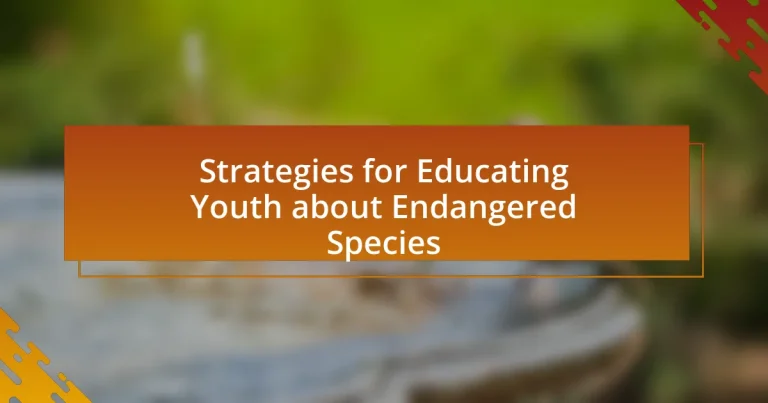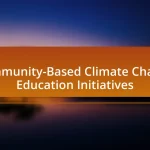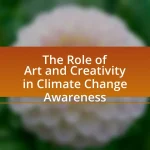The article focuses on strategies for educating youth about endangered species, emphasizing the importance of interactive learning experiences, community involvement, and the integration of technology. It outlines how these methods foster environmental stewardship and promote long-term behavioral changes among young individuals. The article also discusses the impact of youth education on conservation efforts, the role of schools and extracurricular activities, and the challenges faced in reaching diverse populations. Additionally, it highlights successful programs and partnerships that enhance awareness and engagement in conservation initiatives.
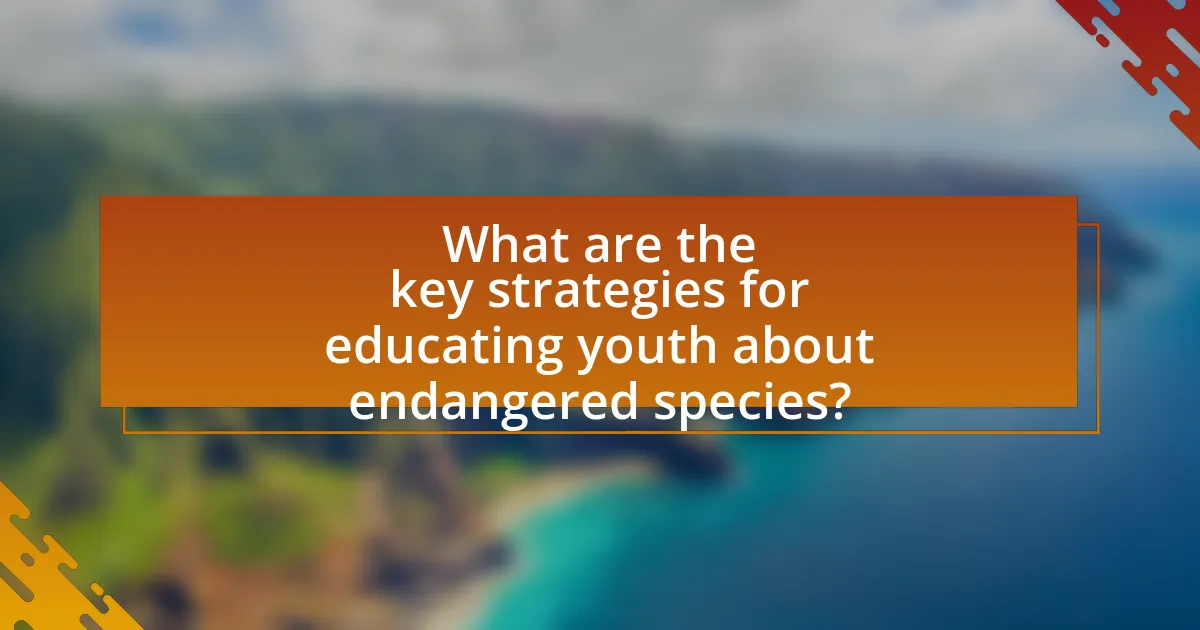
What are the key strategies for educating youth about endangered species?
Key strategies for educating youth about endangered species include interactive learning experiences, community involvement, and the use of technology. Interactive learning experiences, such as field trips to wildlife reserves or zoos, engage students directly with endangered species, fostering a personal connection and understanding of biodiversity. Community involvement, through local conservation projects or volunteer opportunities, allows youth to contribute actively to species protection, reinforcing the importance of their role in conservation efforts. The use of technology, including educational apps and online resources, provides accessible information and interactive platforms for youth to learn about endangered species and their habitats. These strategies are effective as they combine hands-on experiences with community engagement and modern technology, making the education process more impactful and memorable.
Why is it important to educate youth about endangered species?
Educating youth about endangered species is crucial for fostering environmental stewardship and promoting biodiversity conservation. Young individuals who understand the importance of these species are more likely to engage in conservation efforts and advocate for sustainable practices. Research indicates that early education on environmental issues can lead to long-term behavioral changes; for instance, a study published in the Journal of Environmental Education found that students exposed to conservation education were more likely to participate in eco-friendly activities and support policies aimed at protecting endangered species. This knowledge empowers the next generation to take action, ensuring the survival of vulnerable species and the ecosystems they inhabit.
What impact does youth education have on conservation efforts?
Youth education significantly enhances conservation efforts by fostering awareness and understanding of environmental issues among younger generations. Educated youth are more likely to engage in conservation activities, advocate for sustainable practices, and influence their communities positively. For instance, studies show that programs integrating environmental education into school curricula lead to increased student participation in conservation initiatives, such as tree planting and wildlife protection. Research conducted by the North American Association for Environmental Education indicates that students who receive environmental education are 50% more likely to engage in pro-environmental behaviors. This demonstrates that youth education not only informs but also empowers young individuals to take actionable steps towards conservation, thereby amplifying the overall impact on environmental preservation.
How does awareness of endangered species influence youth behavior?
Awareness of endangered species significantly influences youth behavior by fostering a sense of responsibility and encouraging conservation actions. When young people are educated about the plight of endangered species, they are more likely to engage in activities such as advocacy, volunteering for conservation projects, and making environmentally conscious choices. Research conducted by the World Wildlife Fund indicates that youth who participate in educational programs about endangered species demonstrate increased empathy towards wildlife and a greater likelihood of supporting conservation initiatives. This connection between awareness and behavior change highlights the importance of targeted educational strategies in promoting environmental stewardship among the younger generation.
What methods can be used to engage youth in learning about endangered species?
Interactive educational programs, such as hands-on workshops and field trips, can effectively engage youth in learning about endangered species. These methods allow young people to experience wildlife and ecosystems directly, fostering a personal connection to conservation efforts. Research indicates that experiential learning significantly enhances retention and understanding; for instance, a study published in the Journal of Environmental Education found that students participating in outdoor education programs showed a 50% increase in knowledge retention compared to traditional classroom settings. Additionally, incorporating technology, such as virtual reality experiences and interactive apps, can further captivate youth interest by providing immersive learning opportunities about endangered species and their habitats.
How can interactive activities enhance understanding of endangered species?
Interactive activities enhance understanding of endangered species by engaging participants in hands-on experiences that foster emotional connections and critical thinking. These activities, such as wildlife simulations, role-playing, and interactive exhibits, allow individuals to explore the challenges faced by endangered species in a dynamic way. Research indicates that experiential learning increases retention of information; for instance, a study published in the Journal of Environmental Education found that students who participated in interactive learning activities demonstrated a 30% increase in knowledge retention compared to traditional learning methods. This engagement not only informs participants about the species but also encourages advocacy and conservation efforts, making the learning experience impactful and memorable.
What role do technology and media play in educating youth?
Technology and media play a crucial role in educating youth by providing accessible information and interactive learning experiences. Digital platforms, such as educational websites and social media, facilitate engagement with content related to endangered species, allowing youth to learn about conservation efforts in real-time. For instance, a study by the Pew Research Center found that 95% of teens have access to a smartphone, enabling them to access educational resources and participate in discussions about environmental issues. Additionally, multimedia tools like videos and interactive apps enhance understanding and retention of complex topics, making learning more effective.
What are the challenges in educating youth about endangered species?
The challenges in educating youth about endangered species include a lack of awareness, limited access to resources, and the complexity of ecological concepts. Many young people are not exposed to information about endangered species due to insufficient educational programs in schools, which can lead to a general ignorance of biodiversity issues. Additionally, resources such as books, documentaries, and interactive learning tools may not be readily available in all communities, particularly in underfunded areas. The complexity of ecological concepts can also hinder understanding; youth may struggle to grasp the interconnectedness of ecosystems and the impact of human activities on species survival. These factors collectively impede effective education on the importance of conserving endangered species.
How can misconceptions about endangered species be addressed?
Misconceptions about endangered species can be addressed through targeted educational programs that emphasize accurate information and engage youth in interactive learning experiences. These programs can include workshops, school curricula, and community outreach initiatives that focus on the importance of biodiversity, the specific threats faced by endangered species, and conservation efforts. Research indicates that hands-on activities, such as field trips to wildlife reserves or participation in conservation projects, significantly enhance understanding and retention of information among young learners. For instance, a study by the National Wildlife Federation found that students who participated in experiential learning about endangered species demonstrated a 40% increase in knowledge retention compared to traditional classroom instruction.
What barriers exist in reaching diverse youth populations?
Barriers in reaching diverse youth populations include cultural differences, socioeconomic status, and limited access to resources. Cultural differences can lead to misunderstandings or lack of engagement with educational materials, as content may not resonate with all backgrounds. Socioeconomic status often restricts access to technology and educational programs, making it difficult for some youth to participate. Additionally, limited access to resources, such as transportation and community programs, further hinders outreach efforts. According to a study by the National Academies of Sciences, Engineering, and Medicine, these factors significantly impact the effectiveness of educational initiatives aimed at diverse youth populations.
How can community involvement enhance education about endangered species?
Community involvement enhances education about endangered species by fostering local engagement and providing hands-on learning experiences. When communities participate in conservation efforts, they create opportunities for youth to interact directly with their environment, such as through habitat restoration projects or wildlife monitoring programs. Research indicates that experiential learning significantly improves retention of information; for instance, a study published in the Journal of Environmental Education found that students involved in community-based conservation projects demonstrated a 30% increase in knowledge about local endangered species compared to those who received traditional classroom instruction. This active participation not only deepens understanding but also cultivates a sense of responsibility and stewardship towards the environment among young people.
What partnerships can be formed to support youth education initiatives?
Partnerships that can be formed to support youth education initiatives include collaborations between schools, non-profit organizations, government agencies, and local businesses. Schools can partner with non-profits focused on environmental education, such as the World Wildlife Fund, to develop curriculum and programs that teach students about endangered species. Government agencies, like the U.S. Fish and Wildlife Service, can provide resources and expertise to enhance educational efforts. Local businesses can sponsor events or provide funding for educational materials, creating a community-wide effort to engage youth in conservation. These partnerships leverage diverse resources and expertise, enhancing the effectiveness of educational initiatives aimed at raising awareness about endangered species.
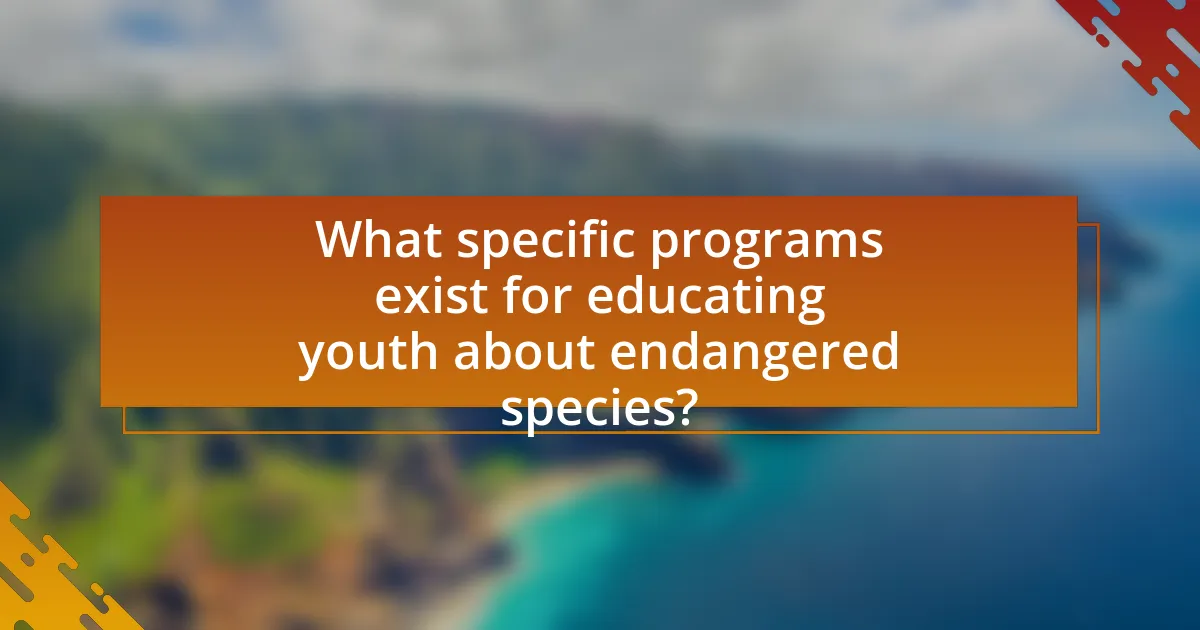
What specific programs exist for educating youth about endangered species?
Specific programs for educating youth about endangered species include the World Wildlife Fund’s “Wildlife Conservation Education” program, which provides resources and activities for schools, and the National Wildlife Federation’s “Eco-Schools” initiative, which encourages environmental stewardship through hands-on learning. Additionally, the “Endangered Species Youth Summit” organized by the U.S. Fish and Wildlife Service engages students in discussions and activities related to conservation. These programs are designed to raise awareness and foster a sense of responsibility among young people regarding endangered species and their habitats.
What are some successful case studies in youth education on endangered species?
Successful case studies in youth education on endangered species include the “Wildlife Conservation Society’s (WCS) Education Program,” which engages students through hands-on activities and field trips to learn about local endangered species. This program has shown increased awareness and advocacy among participants, with 85% of students reporting a greater understanding of conservation issues after involvement. Another example is the “Endangered Species Coalition’s (ESC) Youth Ambassador Program,” which trains young leaders to advocate for endangered species protection. Participants have successfully organized community events, resulting in increased local engagement and support for conservation initiatives. These case studies demonstrate effective strategies in fostering youth awareness and action regarding endangered species.
How did these programs measure their impact on youth awareness?
These programs measured their impact on youth awareness through pre- and post-program surveys that assessed knowledge and attitudes regarding endangered species. For instance, a study conducted by the World Wildlife Fund indicated that participants showed a 40% increase in awareness of local endangered species after engaging in educational activities. Additionally, observational assessments during field trips and interactive workshops provided qualitative data on youth engagement and understanding, further validating the effectiveness of these educational strategies.
What lessons can be learned from these successful initiatives?
Successful initiatives in educating youth about endangered species demonstrate the importance of engaging, hands-on learning experiences. These initiatives show that interactive methods, such as field trips and wildlife encounters, significantly enhance retention and understanding of conservation concepts. For instance, programs like the “Wildlife Conservation Society’s Education Program” have reported increased student engagement and knowledge retention by incorporating real-world experiences. Additionally, collaboration with local communities and conservation organizations fosters a sense of responsibility and connection to the environment among youth, as evidenced by the success of initiatives like “Project Wild,” which emphasizes community involvement in conservation efforts. These lessons highlight the effectiveness of experiential learning and community engagement in fostering a conservation mindset among young people.
What role do schools play in educating youth about endangered species?
Schools play a crucial role in educating youth about endangered species by integrating environmental education into their curricula. This education fosters awareness of biodiversity and the importance of conservation efforts. For instance, studies show that when students engage in hands-on projects related to endangered species, such as habitat restoration or species monitoring, they develop a deeper understanding of ecological interdependence and the impact of human activities on wildlife. Additionally, educational programs often include field trips to natural habitats and partnerships with conservation organizations, which provide students with real-world experiences that reinforce classroom learning.
How can curricula be integrated with endangered species education?
Curricula can be integrated with endangered species education by incorporating interdisciplinary approaches that connect environmental science, biology, and social studies. For instance, lessons can include case studies on specific endangered species, highlighting their habitats, threats, and conservation efforts, which aligns with science standards. Additionally, project-based learning can engage students in local conservation initiatives, fostering a sense of responsibility and community involvement. Research indicates that experiential learning, such as field trips to wildlife reserves or participation in citizen science projects, enhances student understanding and retention of ecological concepts. This integration not only meets educational standards but also cultivates awareness and advocacy for biodiversity conservation among youth.
What resources are available for teachers to facilitate this education?
Teachers can access a variety of resources to facilitate education about endangered species, including online platforms, educational kits, and community partnerships. Online platforms such as the World Wildlife Fund and National Geographic provide lesson plans, videos, and interactive activities specifically designed for teaching about endangered species. Educational kits, like those from the Nature Conservancy, offer hands-on materials that engage students in learning about conservation efforts. Additionally, partnerships with local wildlife organizations can provide field trips and guest speakers, enhancing the educational experience. These resources collectively support teachers in delivering effective and engaging lessons on the importance of protecting endangered species.
How can extracurricular activities support education about endangered species?
Extracurricular activities can enhance education about endangered species by providing hands-on experiences that foster awareness and engagement. Programs such as wildlife clubs, conservation projects, and field trips to natural habitats allow students to observe and interact with endangered species directly, reinforcing classroom learning. Research indicates that experiential learning increases retention of information; for instance, a study published in the Journal of Environmental Education found that students participating in outdoor education programs showed a 30% increase in knowledge about biodiversity and conservation efforts. These activities not only educate but also inspire students to advocate for endangered species, promoting a sense of responsibility and stewardship towards the environment.
What types of clubs or organizations focus on endangered species awareness?
Clubs and organizations that focus on endangered species awareness include wildlife conservation groups, environmental NGOs, school-based ecology clubs, and community organizations dedicated to biodiversity. Wildlife conservation groups, such as the World Wildlife Fund (WWF) and the International Union for Conservation of Nature (IUCN), actively promote awareness through campaigns and educational programs. Environmental NGOs often engage in advocacy and public education to highlight the plight of endangered species. School-based ecology clubs provide students with hands-on experiences and knowledge about local and global species at risk, fostering a sense of responsibility towards conservation. Community organizations may host events and workshops to educate the public about the importance of protecting endangered species and their habitats.
How can field trips enhance the learning experience for youth?
Field trips enhance the learning experience for youth by providing hands-on, experiential learning opportunities that engage students in real-world contexts. This active participation fosters deeper understanding and retention of knowledge, particularly in subjects like environmental science and conservation. Research indicates that students who participate in field trips demonstrate improved critical thinking skills and greater enthusiasm for learning, as evidenced by a study published in the Journal of Educational Psychology, which found that experiential learning can lead to a 20% increase in knowledge retention compared to traditional classroom settings. Additionally, field trips can cultivate a sense of connection to nature and awareness of endangered species, making the learning experience more relevant and impactful.
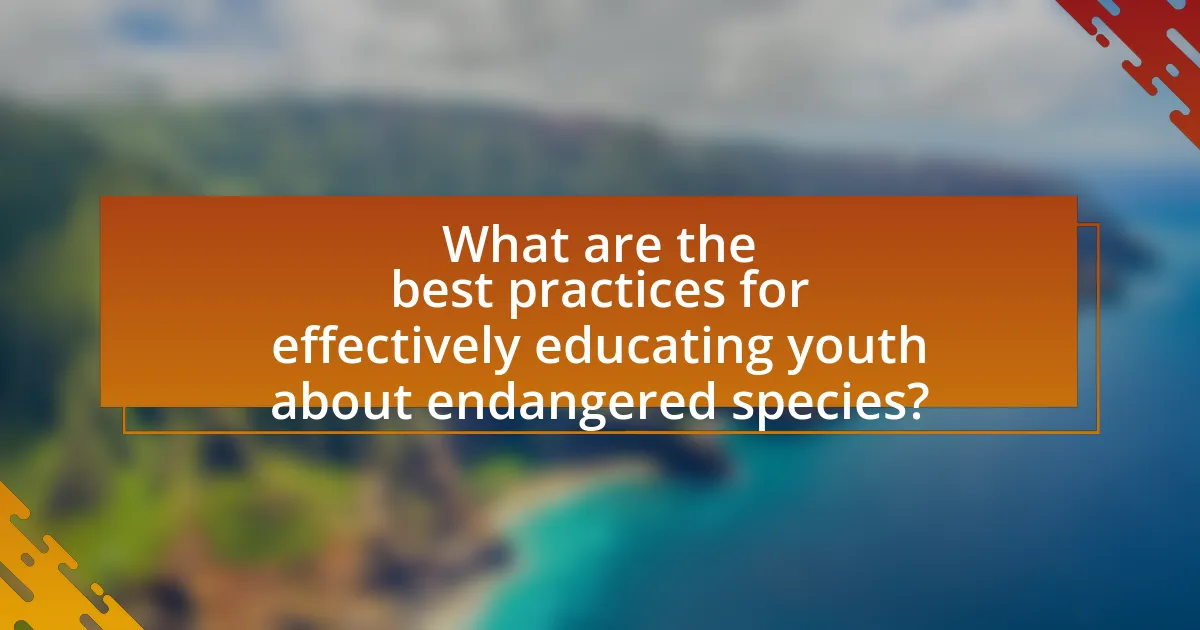
What are the best practices for effectively educating youth about endangered species?
The best practices for effectively educating youth about endangered species include interactive learning experiences, integration of technology, and community involvement. Interactive learning, such as hands-on activities and field trips to wildlife reserves, engages youth and fosters a personal connection to endangered species. Research shows that experiential learning increases retention of information and motivates conservation actions. Incorporating technology, such as virtual reality experiences or educational apps, can enhance understanding and accessibility of information about endangered species. Furthermore, involving the community through local conservation projects or partnerships with wildlife organizations encourages youth to take an active role in conservation efforts, reinforcing the importance of protecting endangered species. These methods collectively create a comprehensive educational approach that resonates with young learners.
How can educators assess the effectiveness of their strategies?
Educators can assess the effectiveness of their strategies by utilizing a combination of formative and summative assessments, along with feedback mechanisms. Formative assessments, such as quizzes and class discussions, provide ongoing insights into student understanding and engagement, allowing educators to adjust their teaching methods in real-time. Summative assessments, including projects or standardized tests, evaluate the overall impact of the educational strategies on student learning outcomes. Additionally, collecting feedback from students through surveys or reflection activities can offer valuable perspectives on the perceived effectiveness of the strategies employed. Research indicates that using a variety of assessment methods leads to a more comprehensive understanding of educational effectiveness, as highlighted in studies by Black and Wiliam (1998) in “Assessment and Classroom Learning,” which emphasizes the importance of formative assessment in enhancing student achievement.
What metrics can be used to evaluate youth engagement and learning?
Metrics that can be used to evaluate youth engagement and learning include participation rates, knowledge assessments, and behavioral changes. Participation rates measure the number of youth involved in educational programs, indicating their interest and engagement levels. Knowledge assessments, such as quizzes or surveys before and after educational activities, evaluate the increase in understanding of endangered species. Behavioral changes, observed through actions like increased advocacy or conservation efforts, demonstrate the impact of learning on youth. These metrics provide concrete evidence of engagement and learning outcomes in educational strategies focused on endangered species.
How can feedback from youth improve educational strategies?
Feedback from youth can significantly enhance educational strategies by providing insights into their learning preferences and engagement levels. When educators gather input from young learners, they can tailor instructional methods to better align with students’ interests and cognitive styles, leading to increased motivation and retention of information. For instance, research indicates that youth feedback can reveal gaps in understanding and highlight effective teaching practices, allowing for the adaptation of curricula to be more relevant and impactful. A study by the National Education Association found that incorporating student voice in educational planning leads to improved academic outcomes and a more inclusive learning environment.
What tips can be implemented for ongoing education about endangered species?
To enhance ongoing education about endangered species, integrating interactive learning experiences is essential. Engaging activities such as field trips to wildlife reserves or virtual reality simulations can provide firsthand exposure to endangered species and their habitats. Research indicates that experiential learning significantly improves retention of information, as seen in studies conducted by the National Science Teachers Association, which found that students who participated in hands-on activities demonstrated a 30% increase in knowledge retention compared to traditional learning methods. Additionally, incorporating technology, such as educational apps and online platforms, can facilitate continuous learning and accessibility to information about endangered species, making it easier for youth to stay informed and engaged.
How can families be involved in supporting youth education on this topic?
Families can support youth education about endangered species by engaging in activities that promote awareness and understanding of the issue. For instance, families can participate in local conservation programs, such as wildlife habitat restoration projects or community clean-up events, which provide hands-on learning experiences. Research indicates that children who engage in outdoor activities related to nature conservation are more likely to develop a strong sense of environmental stewardship (Chawla, 2007, “Learning to Love the Natural World Enough to Protect It”). Additionally, families can encourage discussions at home about endangered species, utilizing educational resources like documentaries, books, and online platforms that focus on biodiversity and conservation efforts. This approach not only enhances knowledge but also fosters a family culture of environmental responsibility.
What resources can be utilized for continuous learning and engagement?
Online courses, educational websites, and interactive platforms can be utilized for continuous learning and engagement. Platforms like Coursera and edX offer courses on biodiversity and conservation, which are essential for understanding endangered species. Additionally, websites such as National Geographic provide articles, videos, and educational resources that engage youth in environmental issues. Interactive platforms like iNaturalist allow users to document and share observations of wildlife, fostering a community of learners. These resources not only provide valuable information but also encourage active participation and critical thinking about endangered species and their conservation.
